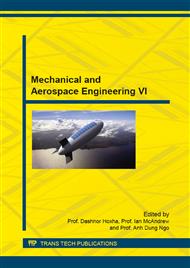[1]
H. Oudin, Méthode des éléments finis, Ecole d'ing´enieur. Nantes, France. 2008, p.74.
Google Scholar
[2]
T. Schermann , J. Marsolek , C. Schmidt, J. Fleischer, Aspects of the simulation of a cutting process with ABAQUS/Explicit including the interaction between the cutting process and the dynamic behavior of the machine tool, 9th CIRP International Workshop on Modeling of Machining Operations, May 11-12, (2006).
Google Scholar
[3]
P. J. Arrazola, D. Ugarte, J. Montoya, A. Villar, S. Marya, Finite element modeling of chip formation process with Abaqus/Explicit M 6. 3, (2005).
Google Scholar
[4]
D. R. Lesuer, Experimental investigations of material models for Ti–6Al–4V Titanium and 2024-T3 Aluminium. U.S. Department of Transportation Federal Aviation Administration, (2000); DOT/FAA/AR-00/25.
Google Scholar
[5]
R. Muhammad, N. Ahmed, Y. M. Shariff and V. V. Silberschmidt, Finite-Element Analysis of Forces in Drilling of Ti-Alloys at Elevated Temperature, Solid State Phenomena Vol. 188, (2012), pp.250-255.
DOI: 10.4028/www.scientific.net/ssp.188.250
Google Scholar
[6]
W. Mieszczak, K. Lis, FEM temperature modeling in drilling process, 14th International Research/Expert Conference" Trends in the Development of Machinery and Associated Technology" TMT 2010, Mediterranean Cruise, 11-18 Sept. (2010).
Google Scholar
[7]
R. Muhammad, N. Ahmed, Y.M. Shariff, V.V. Silberschmidt, Effect of cutting conditions on temperature generated in drilling process: A FEA approach, Advanced Materials Research. 223 (2011) 240-246.
DOI: 10.4028/www.scientific.net/amr.223.240
Google Scholar
[8]
X. Zhang, et al., Predicting the Effects of Cutting Parameters and Tool Geometry on Hard Turning Process Using Finite Element Method. Journal of Manufacturing Science and Engineering, 2011. 133.
DOI: 10.1115/1.4004611
Google Scholar
[9]
O. Isbilir, E. Ghassemieh, Finite Element Analysis of Drilling of Titanium Alloy, Procedia Engineering 10 (2011) 1877–1882.
DOI: 10.1016/j.proeng.2011.04.312
Google Scholar
[10]
R. Zitoune, V. Krishnaraj, F. Collombet, Study of drilling of composite material and aluminium stack, Composite Structures 92 (2010) 1246–1255.
DOI: 10.1016/j.compstruct.2009.10.010
Google Scholar
[11]
N. Glaa, K. Mehdi and M. Ben Jaber, Numerical Model for Prediction of Cutting Forces in a Vibratory Drilling Process, Advanced Materials Research Vol. 1016 (2014) pp.215-220.
DOI: 10.4028/www.scientific.net/amr.1016.215
Google Scholar


